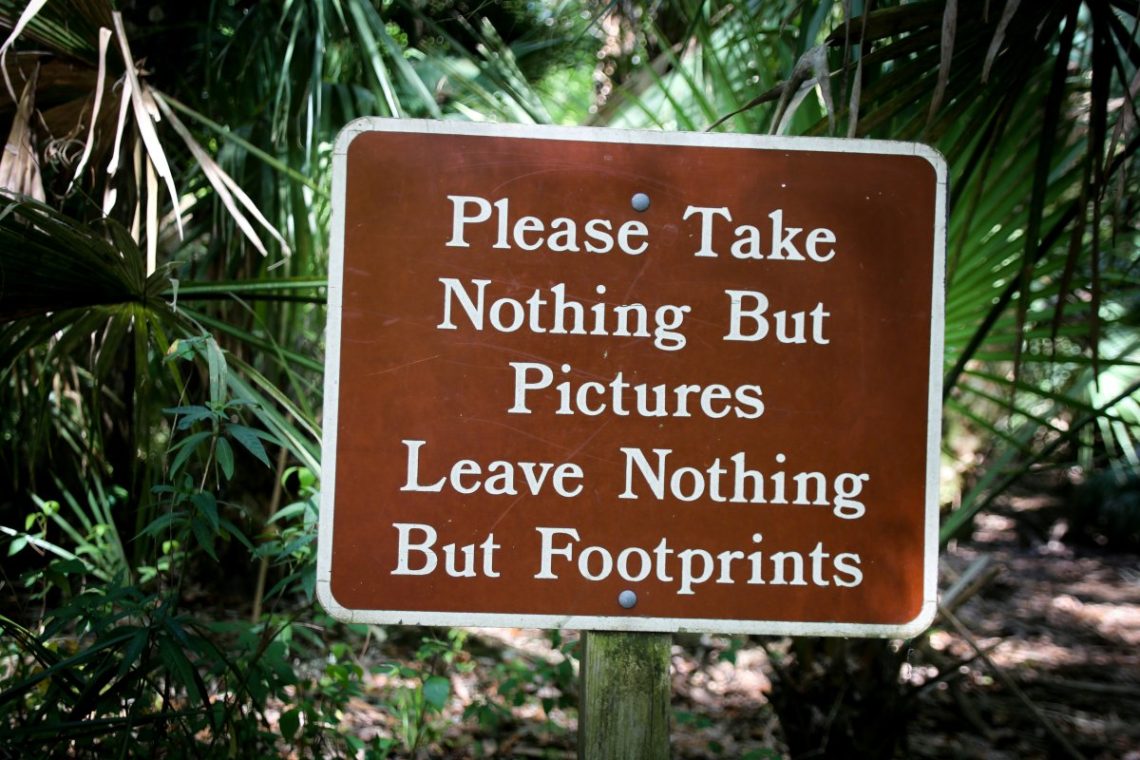
Traveling Green: The Importance of Eco-Friendly Travel
As more of us feel the call to explore new places, the need to travel responsibly has never been more pressing. While our adventures improve our understanding of the world, they can often leave an unintentional toll on the environment.
From destroying natural landscapes to contributing significantly to global carbon emissions, the negative impact of tourism is undeniable. This is why we must embrace the concept of eco-friendly travel, a method of exploration focused on minimizing our environmental footprint while supporting local communities.
This article aims to shed light on the issue and provide practical advice on low-impact, sustainable travel to help you make better choices the next time you pack your bags.
How does Tourism Impact the Environment?

Well, the truth is, tourism, and especially mass tourism, can have a tremendous impact on the environment. It’s like throwing a stone into a pond – the ripples extend far beyond the direct path. Now, let’s narrow down the picture.
First, there’s the carbon emissions.Tourism actually accounts for 8% of global greenhouse gas emissions. Each time you hop into a plane, you’re contributing to the release of numerous greenhouse gases into the atmosphere. These are major players in global warming, which leads to climate change. But it’s not just air travel – even journeys by car or bus add to the overall emissions.
Water pollution is another negative effect of tourism. It could be from polluted waters from tourism vessels, waste disposal from hotels, or littering on beaches and in oceans – all these leading to massive water pollution.
And then, there’s the issue of deforestation and biodiversity loss. To make way for hotels, resorts, and other tourism-related facilities, massive swathes of forests are often cleared. This destruction disrupts the habitats of countless species, leading to a loss of biodiversity on a massive scale.
“The Earth does not belong to man, man belongs to the Earth. All things are connected like the blood that unites us all. Man did not weave the web of life, is he merely a strand in it. Whatever he does to the web, he does to himself.” -Chief Seattle
Moreover, the increase in waste production is another challenge. Tourist activities inevitably generate a lot of waste, including plastic bags, bottles, food waste, and more. This waste can end up in landfills or the ocean, causing further damage to the environment.
And last but not least, tourism can lead to cultural degradation. With a high influx of tourists, local cultures may be diluted or even lost as locals bend over backward to cater to tourists.
Another part, often misconceived as eco-friendly travel, is greenwashing, but we’ll not be getting into that now. Understandably, it’s a lot to take in. But don’t worry, we can, and we will, figure out how to travel in a more eco-friendly manner.
What is eco-friendly travel?
When we talk about eco-friendly travel, it refers to a way of traveling that promotes sustainability and causes minimal harm to the environment.
Often associated with terms like ‘green travel’, ‘responsible tourism’, or ‘sustainable travel’, eco-friendly travel essentially means a travel approach that considers the well-being of the planet, its ecosystem, and its inhabitants – both people and animals.
Now, this sounds pretty big, doesn’t it? But believe it, it’s not something overwhelming. It’s all about making mindful decisions.
What are the benefits of eco-friendly travel?
An important question you might have in mind is this: “What’s in it for me?” Rightfully so. You may understand the environmental imperative, but how does eco-friendly travel benefit you personally, right? Let’s dive into the benefits eco-friendly travel can bring to you.
Heath Boost
First up, let’s talk health. Cleaner environments equate to better health. By choosing eco-friendly options, such as walking or cycling over car rentals, or participating in outdoor activities instead of indoor, you dramatically cut down on pollution intake. Additionally, this connects you more deeply with nature, which has proven mental health benefits, as well.
Local and Authentic Experiences
Think about it. Isn’t it a bit more authentic to visit the local farmers market for your groceries, rather than a conventional supermarket? It’s rich in local culture, providing a truly authentic experience. Eco-friendly travel often combines supporting local businesses and trying new experiences, adding a unique and personal touch to your journey.
Economic Savings
While it can sometimes be more costly upfront to be eco-conscious, in the long run, it can offer considerable savings. Take for example, using refillable water bottles as opposed to buying disposable ones, or using public transport or bike rentals as opposed to taxis or rental cars.
A Sustainable Future
Moreover, by practicing eco-friendly travel, you’re playing a crucial part in shaping the future of tourism. Every choice and action, whether it’s opting for eco-friendly accommodation or choosing a responsible wildlife tour, shapes the future of travel, pushing it towards more sustainable practices.
What are some examples of eco-friendly travel practices?

Being an eco-friendly traveler is about more than just reducing your carbon footprint. It’s also about respecting the local cultures, economies, and environments you visit. Eco-friendly travel options, such as using public transportation or cycling, can reduce carbon emissions. But let’s explore some ways you can make your travels more sustainable.
Eco-Mode
An effective way to reduce your carbon footprint while traveling is by focusing on how you travel. Wherever possible, choose the eco-mode option when booking flights or renting vehicles. It’s an initiative designed to optimize fuel efficiency, ultimately resulting in fewer emissions and consequently less pollution.
Use Reusable Goods
One of the most straightforward measures you can take to protect the environment as a tourist is by reducing waste. You can achieve this by packing reusable items. The list of potential goods is extensive – from water bottles and shopping bags to cutlery, straws, and containers. By making these simple swaps, you can significantly minimize your waste output.
Stay Local
Next on the journey towards sustainable tourism: accommodation. The hotel industry is a major contributor to waste generation, water consumption, and energy usage. Staying in locally owned accommodations not only provides support for the local economy but can also lessen your carbon footprint. This is because such establishments are often smaller and operate more efficiently than their larger counterparts.
Practice Responsible Tourism
It’s imperative to remember, as a traveler, you are a guest in someone else’s home. Always respect local customs and habits. The more you understand and respect, the more significant and positive your impact as a responsible tourist will be.
Support Local Businesses
This message cannot be overstated – support local businesses. Whether you’re dining out, shopping for souvenirs, or purchasing local gifts – opt for businesses that are local wherever possible.
Use Public Transportation
Additionally, you can streamline your local exploration by opting for environmentally friendly and locally beneficial transport options. Using choices like buses, trains, bicycles, or even walking can significantly decrease your environmental footprint.
Join Cleanup Activities
It’s important to note that these practices are not exhaustive. However, implementing them in your travel routines can set a stage for more sustainable and respectful travel experiences, leading the way for others to follow suit.
What are some sustainable transportation options for travel?

When the question of travel arises, there’s often a focus on the destination. How we plan to get there, though, is an equally important factor to mull over.
In an effort to decrease your carbon footprint and the overall impact on the environment, it might be time to swap out those gas-guzzling vehicles for some sustainable transportation options. But what are they, you ask?
Bicycling
If your desired destination is within a manageable distance, why not opt for two wheels instead of four? Bicycling is not only a zero-emission mode of transport, but it also offers the opportunity to soak in the breathtaking scenery often missed when you speed by in a vehicle. Undeniebly the king of eco-friendly travel!
Walking
Similar to bicycling, walking is another mode of zero-emission travel. It may be a touch slower, but the chance to immerse yourself in the local vibe of a new place can offer a unique and enriching experience.
Public Transit
Buses, trams, and trains often reach the same destinations as cars while contributing far less to individual environmental impact. This is particularly true in cities boasting robust public transportation infrastructure.
Carpooling
If car travel is unavoidable, why not share the ride? Carpooling effectively reduces the number of vehicles on the road, leading to a notable reduction in emissions per person.
Hybrids and Electric Vehicles
If you’re in need of a rental car at your destination, consider requesting a hybrid or an electric vehicle. These cars significantly reduce, or completely eliminate, the carbon emissions associated with traditional vehicle travel.
Are there eco-friendly accommodations available?
Yes, eco-friendly accommodations are indeed available and are an essential aspect of responsible travel. These accommodations make sincere efforts to reduce their environmental footprint, promote social responsibility, and use resources sustainably. Their overall objective is to contribute towards a healthier planet.
The concept behind eco-friendly accommodations is simple but compelling: they aim to cause minimal or zero harm to the surrounding environment. This is accomplished in many ways, which could include energy and water conservation, waste reduction, recycling programs, and the use of environmentally-friendly cleaning products.
As a traveler, you’ll have plenty of options for eco-friendly lodging, from budget-friendly hostels to luxury eco-resorts. Let’s look at what makes accommodations eco-friendly:
- Energy-efficient operations: Most eco-friendly travel accommodations make use of renewable energy sources such as solar or wind power. They also often employ energy-saving technologies like LED lighting and energy-efficient appliances.
- Water conservation: Eco-friendly establishments apply water-saving practices like rainwater harvesting, greywater recycling, and water-efficient appliances and fixtures.
- Waste reduction and recycling: These places will often encourage guests to participate in their recycling programs and might integrate composting facilities for food waste. To minimize waste, they may also promote reusable items instead of disposable ones.
- Responsible sourcing: Eco-friendly accommodations typically prioritize locally sourced, organic, and fair-trade food and beverages, contributing to the local economy and reducing carbon emissions from transportation.
Staying in eco-friendly accommodations not only enables you to help reduce your travel’s environmental impact, but it also allows you to support businesses that value sustainability and give back to their communities.
So next time you plan a trip, consider staying at an eco-friendly establishment. Your choices can make a significant difference in promoting a more sustainable travel industry.
How can I support local communities and economies while traveling?
Traveling is not only an opportunity to see the world but also a chance to actively participate in shaping the world for the better. Supporting local communities through responsible tourism can help preserve cultural heritage and traditions.
One important aspect of making a positive difference is supporting the local communities and economies of the places you visit. But just how does one go about doing this in a meaningful way, you ask? Here are some insights!
Buy locally-made products
One of the ways you can contribute positively to your travel destinations is by choosing to buy local. Instead of purchasing souvenirs from big chain stores that most likely don’t directly contribute to the local economy, opt for locally-made products.
This supports local artisans and businesses, circulating money within the community rather than sending it offshore to corporate entities.
Respect local customs and traditions
When you travel, it’s also important to practice respect for local customs and traditions. This will not only enhance your own travel experience but also communicates your appreciation for the local culture to the residents. It’s a meaningful way to cultivate positive interactions between tourists and local communities, deepening your understanding and connection with the place you’re visiting.
Choose locally owned and operated accommodations
Rather than booking your stay at large, international hotel chains, consider finding locally owned hotels, guest houses, or homestays. This ensures that the money you spend on accommodation goes directly back into the local economy, supporting local business owners. Plus, it tends to provide a more personal and authentic experience.
Take part in community-based tourism
Another rewarding approach to eco-friendly travel is to participate in community-based tourism initiatives. These are often designed to directly benefit the local people and frequently provide a unique perspective on the local culture and lifestyle. Participating in these initiatives ensures your tourist dollars are making a real difference in the communities you visit.
Hire locally
If you require services like a guide for a trek or a driver for the day, try to hire directly from local individuals or companies if possible. This way, your money goes straight to the person providing the service, further supporting the local economy. It’s a win-win scenario; you get the local expertise and they benefit from your patronage.
Eat Locally
Finally, choose to dine at local establishments over international chain restaurants. Not only will you have a more authentic (and likely, more delicious) dining experience, but you’re also directly supporting local businesses. Many of these businesses source their ingredients from local farmers and suppliers, so your meal is also a contribution to local agriculture.
By making these choices while traveling, you can help strengthen and uplift local communities. So, turn your journeys into opportunities for positive change. Remember, every small effort counts!
What are some eco-friendly activities to do while traveling?

Experiencing new places doesn’t mean you have to negatively impact the environment. There are a plethora of activities you can embark on that are not only fun but also eco-friendly. Eco-conscious travel includes making smart choices about the activities you participate in during your travels. Here are a few suggestions:
Nature Trekking
When it comes to eco-friendly activities during your travels, hiking or trekking are excellent choices. These low-impact activities promote physical fitness and enable you to appreciate the natural beauty of the place you’re visiting. Be sure always to remain on designated paths to minimize damage to local flora and fauna.
Sustainable Shopping
Choosing sustainable shopping is another way to reduce ecological impact. Opt for local markets over souvenir shops lined with factory-produced goods. This alternative not only supports the local economy but also encourages the creation of products made sustainably and through traditional methods.
Wildlife Observing
If you’re a wildlife enthusiast, opt for wildlife observation rather than encounters with caged or captivated animals. It’s crucial to respect the natural habitats of animals and to maintain a safe and non-disruptive distance.
Volunteering
There are plenty of places worldwide that offer ecological volunteering programs. Such programs provide an opportunity to lend a hand in causes you care about, be it reforestation, marine conservation, or animal rescues. This can make your trip even more meaningful and beneficial to local communities.
Exploring on Foot or Bike
Finally, consider walking or cycling for exploration instead of hiring a car or taking taxis. Aside from the absence of greenhouse gas emissions, these transportation modes offer a more immersive and ground-level view of your surroundings.
Choosing the Right Eco-friendly Activity
When choosing eco-friendly activities, consider the following:
- Is it locally run? Local activities tend to have a smaller carbon footprint, as materials and staff don’t need to travel far. Plus, you’re supporting the local economy.
- Does it support conservation? Activities that actively contribute to environmental protection, like tree planting or volunteering in a national park, are excellent choices.
- Does it educate you? Education is a crucial aspect of eco-tourism. Look for activities that will teach you something about the local environment, culture, or conservation efforts.
Remember, eco-friendly travel is not just about your impact on the environment, but also your positive impact on the local communities. Always respect and support local norms and traditions. Happy green travels!
Are there any certifications or labels to look for when choosing eco-friendly travel options?

Yes, you’re absolutely on the right track! Conscious travelers such as yourself can rely on various certifications and labels that advocate responsible tourism. These labels provide assurance that the travel option, be it accommodation, transport, or even entire destinations, have committed to environmental stewardship and sustainability. Let’s dive into some of these certifications and what they represent.
| Certification / Label | Environmentally Friendly Practices |
|---|---|
| The Green Globe Certificate | Encompasses sustainability management, social-economic, cultural heritage, and environment strategies |
| The LEED Certification | Efficient in water usage, energy consumption, and waste management, and prioritizes health and human safety measures |
| The Rainforest Alliance Certification | Commits to conserving biodiversity and securing sustainable livelihoods, while adhering to rigorous standards |
| The Blue Flag | Awards stringent environmental, educational, safety, and accessibility criteria to beaches, marinas, and sustainable boating operators |
What are some challenges in implementing eco-friendly travel initiatives?
Indeed, shifting towards eco-friendly travel comes with its set of hurdles. The journey isn’t always simple or straightforward.
Firstly, there’s the issue of awareness. Many travelers aren’t adequately informed about the environmental impact of their travel choices – from the mode of transport to the disposable toiletries at the hotel. This lack of information results in practices that can significantly damage the environment.
‘Knowledge is power’, and hence spreading the word about eco-friendly travel is vital. However, reaching everybody and communicating why such practices are pivotal pose substantial challenges.
Secondly, we have accessibility and affordability. For many, eco-friendly travel options are perceived as more expensive or less accessible. The availability of budget-friendly and straightforward options for green travel is still growing. For example, it might be difficult for some travelers to find an affordable, green accommodation at their chosen destination, or there might be a lack of direct public transport routes, encouraging them to rely on private vehicles instead.
Next is the challenge of convenience. The tourism industry has been built around attracting and accommodating as many people as possible, often prioritizing convenience over sustainability. This means most of the well-established practices and infrastructure in the tourism industry may not be the most eco-friendly or sustainably designed.
Lastly, the challenge of regulations and incentives. There need to be enough regulations in place that encourage eco-friendly behavior and penalize non-environment-friendly practices. Similarly, there should be incentives for companies and individuals who integrate eco-friendly practices into their travel routines.
While these challenges may seem daunting, it’s important to remember that every journey begins with a single step. Recognizing these obstacles is the first move towards finding solutions that can help us travel in a way that respects and preserves our planet.
Final Thoughts
Embracing eco-friendly travel might come with a few hurdles, but its rewards truly make it worth the effort. By adopting sustainable practices, we can explore the world while also preserving it for future generations. It’s not just about seeing new places, it’s about making a difference.
So let’s take that first step towards making our travels more responsible and environmentally friendly. Remember, every small decision counts when it comes to caring for our planet. Happy eco-journeys!



